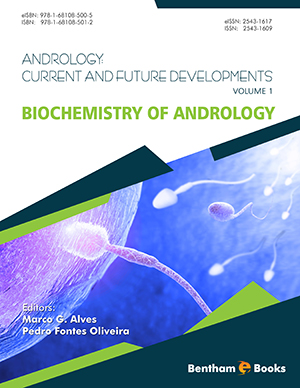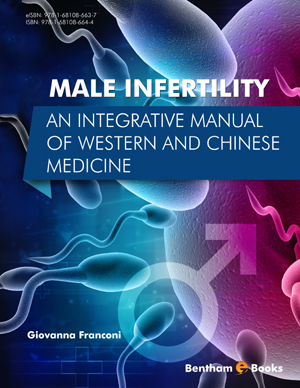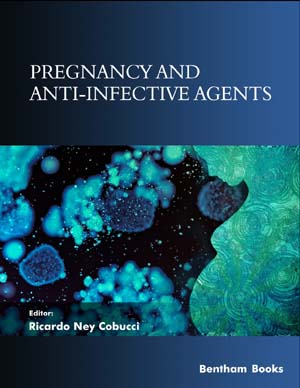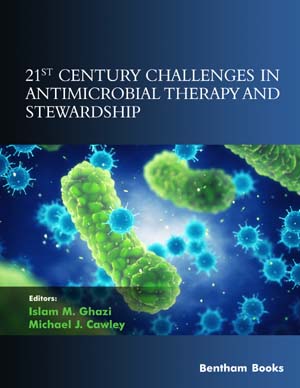Book Volume 2
Blastocystis spp.
Page: 3-24 (22)
Author: Ildebrando Patamia and Marco Giuseppe Prato
DOI: 10.2174/9781681084336117020004
PDF Price: $15
Abstract
Blastocystis spp. are intestinal parasitic protozoa of humans and many other organisms Using molecular approaches the taxonomy of Blastocystis was determined. At present, this parasite is believed to belong to the subclass of Stramenopiles (or Heterokonts), subgroup Opalinata. Blastocystis is the only Stramenopile known to be a human parasite. For this reason it was classified first as Blastocystis hominis, but in the light of new knowledge, the term of Blastocystis spp. is more appropriate In this chapter epidemiology, life cycle and transmission, morphology and structure, laboratory diagnosis including microscopy, culture and molecular techniques are reviewed. Finally, clinical aspects, including the association with irritable bowel syndrome and therapeutic approaches are considered.
Cryptosporidium and Cryptosporidiosis
Page: 25-67 (43)
Author: Simone M. Cacciò and Fabio Tosini
DOI: 10.2174/9781681084336117020005
PDF Price: $15
Abstract
Cryptosporidium spp. has emerged as an important cause of diarrheal disease in humans and animals, with a global distribution. The epidemiology of cryptosporidiosis is complex, and transmission occurs through both direct (human-tohuman, animal-to-human) and indirect (through water and food) routes. In humans, the majority of infections are caused by C. hominis and C. parvum, but a number of other species have been recognized as human pathogens. The burden of disease is particularly high among young children in developing regions of the world, where cryptosporidiosis is one of the major causes of moderate-to-severe diarrhea and is associated with an increased risk of death. In developed countries, contamination of drinking water has caused several large waterborne outbreaks. Effective drug treatments and vaccines are not yet available, but the partial immunity after exposure suggests the potential for developing vaccines. Routine diagnostic methods for Cryptosporidium often have a low sensitivity, and those based on antigen or DNA detection, that greatly improve sensitivity, are underused. Recent advances in nextgeneration sequencing techniques will significantly improve our knowledge of the transmission of Cryptosporidium. However, increased funding will be essential to combat this important pathogen.
Cyclospora cayetanensis
Page: 68-81 (14)
Author: Ynes R. Ortega
DOI: 10.2174/9781681084336117020006
PDF Price: $15
Abstract
The coccidian parasite Cyclospora cayetanensis can cause gastrointestinal illness. It has been associated with consumption of contaminated foods, particularly those eaten raw or minimally processed. First considered a cyanobacteria or coccidianlike organism, in the early 1990s it was characterized as a member of the Cyclospora genus based on morphological properties. This parasite has been associated with travelers’ diarrhea. To date, there is no animal reservoir identified for C. cayetanensis. Waterborne outbreaks have also been reported. In July of 1990, 21 household staff physicians developed diarrheal illness and analysis of their stool specimens showed organisms consistent with Cyclospora oocysts. Epidemiological investigations implicated tap water as the likely source of the outbreak. In another instance, in 1994, British soldiers and their dependents stationed in Nepal developed cyclosporiasis. Local drinking water with chlorine concentrations of 0.3-0.8 ppm was associated with this outbreak and Cyclospora oocysts were isolated from the water. Additionally, imported berries, salad greens, and herbs were associated with foodborne outbreaks of cyclosporiasis in the U.S., Canada, and European countries in the late 1990s. In 2013, 2014, and 2015 C. cayetanensis caused significant outbreaks in the U.S. and were epidemiologically associated with imported salad greens and cilantro. Cyclospora is resistant to many commonly used sanitizers and certain environmental conditions which are found in many locations used to process/package produce. Oocysts can be inactivated by either freezing or heating. Tools for traceback studies and in vitro or in vivo models to propagate this parasite are currently not available.
Cystoisospora belli
Page: 82-102 (21)
Author: Massimiliano Galdiero, Settimia Alfano, Maria Elena Della Pepa, Gianluigi Franci, Claudia Ledda and Marilena Galdiero
DOI: 10.2174/9781681084336117020007
PDF Price: $15
Abstract
Cystoisosporiasis is a human intestinal disease caused by the protozoan parasite Cystoisospora belli. It is an obligate intracellular parasite that invades intestinal epithelial cells. It causes a self-limited or prolonged diarrhea, depending on the host’s immune status. C. belli is cosmopolitan, but more common in the tropics and subtropics. The parasite can be spread by ingesting contaminated food or water. C. belli oocysts are ellipsoid and approximately 25 μm to 33 μm by 10 μm to 20 μm and contain two sporocysts, which contain 4 sporozoites each. Feces are the common way of immature form of the parasite release. The parasite, usually needs between 1 or 2 days in the environment (outside of host) to performe the adequate maturation steps to be able infect further subjects. Watery diarrhea is the most common symptom. Other symptoms can include cramps, abdominal pain, dehydration, loss of appetite, nausea, fever and vomiting. Diagnosis is achieved by oocysts observation via microscopic stool examination. Enhanced detection is obtained by staining stool samples via modified acid-fast stain, modified safranin stain or by fluorescence microscopy. Molecular diagnostic methods have the advantage of high sensibility for an early detection of these coccidian parasites in stool samples. If untreated, immunocompromised individuals may increase the risk for prolonged and severe illness. The usual treatment is with trimethoprim-sulfamethoxazole. Cystoisosporiasis can be prevented with adequate sanitation, measures to protect food and water supplies, and increased public awareness of the means of transmission.
Entamoeba histolytica and other Pathogenic Intestinal Amoebea
Page: 103-123 (21)
Author: Eduardo R. Cobo and Kris Chadee
DOI: 10.2174/9781681084336117020008
PDF Price: $15
Abstract
Entamoeba histolytica is a parasitic enteric protozoan and the etiologic agent of amebic colitis and liver abscess in humans. Amebiasis is commonly acquired through water- and food-borne transmissions and highly prevalent in tropical areas of the world where sanitation is poor. Symptoms can be mild, including loose stools and abdominal cramping but if the parasite invades the colon it can advance to amebic dysentery characterized by frequent watery and bloody stools. Following colonic invasion, trophozoites can enter the bloodstream and lymphatics and disseminate to the liver, heart, lungs, brain, or other organs, to cause abscesses, which if left untreated can lead to death. As treatment for amebiasis with metronidazole has adverse side effects research into novel therapeutics and vaccines is still actively being pursued. The present chapter summarizes the characteristics of amebiasis, their treatments and control and the importance of water transmission.
Free-living Amoebae
Page: 124-149 (26)
Author: Vinay Khanna
DOI: 10.2174/9781681084336117020009
PDF Price: $15
Abstract
Acanthamoeba Species is the most common free living amoeba present in environment. It is isolated from soil, water, contact lens solutions, transplant units and various other hospital environment. There are many species of Acanthamoeba such as A.astronyxis, A.castellani, A.culbertsoni, A.hatchetti, A.keratitis etc. which are known to cause opportunistic infection in both immunocompetent as well as immunocompromised host. Transmission mainly occurs through direct contact. There are two described morphological forms; a trophozoite form and a cyst form. The trophozoites have characteristics pointed thorn like acanthapodias, containing one nucleus with central dense large nucleolus. The cytoplasm measures between 15-50μm, granular and contains various organelles. Clinically patients usually presents with granulomatous amoebic encephalitis (GAE) which is characterized by focal neurological deficit, headache, visual disturbances, seizures and behavioral abnormalities which develops over months to years. Laboratory diagnosis of Acanthamoeba spp. is done by examining CSF which generally shows predominant lymphocytes, elevated proteins and low glucose levels. Histopathological samples of the brain generally reveals cerebral edema, multiple necrotic and hemorrhage lesions. Acanthamoeba can easily be cultivated on non-nutrient agar with overlay of Escherichia coli or Entrobacter spp. Amoeba feeds on bacteria’s and confluent growth is seen in 4-5 days of culturing. The combination therapy is advisable in proven cases of Acanthamoeba infection. Combining Amphotericin B plus Trimethoprim- Sulphamethoxazole plus rifampicin has successfully used in few cases.
Naegleria Fowleri: The organism was first reported in Australia in 1965. It is an environmental ameboflagellate parasite found in variety of water bodies such as ponds, swimming pools; aquarium etc. prefers temperature of 30-45ºC. There are three stages seen in Naegleria life cycle: the infective trophozoites, transient flagellated and the resistant cystic stage. The portal of entity of trophozoites is via olfactory neuroepithelial cell lining covering the cribriform plate to reach olfactory bulb. Demyelination and myelinoclasis are observed in gray matter due to vascular blockage. These pathological changes are attributed to release of phospholipolytic enzymes which causes breaks in the lipid membrane of neuronal cells. Clinically, patients of primary amoebic meningoencephalitis (PAM) usually presented with high grade fever,headache, photophobia and features of raised intracranial pressure. Laboratory diagnosis is done using peripheral smear, CSF examination, culture, histopathological examination and imaging modalities. Hematological findings are leukocytosis with predominant neutrophils. The CSF shows low glucose and high protein levels. Centrifugation of fresh CSF sample up to 500 RPM may reveal motile trophozoites. Morphologically, the size of trophozoites ranges between 12-25μm, with a single nucleus and centrally placed nucleolus in the absence of peripheral chromatin. Liquid culture media such as such as Nelson’s medium containing ox liver digest and glucose are used with serum for growing amoebae. Mammalian cell lines can be employed to demonstrate cytopathic effect. Multiplex PCR detects free living amoeba within 6 hours but routine use in diagnostic laboratory is limited due to rarity of finding these organisms and having high cost of PCR. Brain imaging is easy to perform but restricted by nonspecific findings such as cerebral edema. Specifically, infraction involving frontal, orbital and cerebellum area can be observed in few cases of PAM. There is no optimal treatment regime for Naegleria fowleri. Literature suggests combination therapy works best with amphotericin, rifampicin and azithromycin.
Balamuthia Mandrillaris: Over 200 cases were reported from South America and United States. The true prevalence of disease is unknown in south East Asia. Organism is commonly isolated from soil contact with activities related to soil such as gardening, agriculture pose risk of acquiring the organism. It was first isolated in 1986 from baboon brain that died of meningoencephalitis. The portal of entry of the organism is via cutaneous lesions, nasal mucosa and then subsequent spread to brain. CNS lesions mimic acanthamoeba encephalitis and have chronic slowly progressive course over many years. The life cycle of Balamuthia involves two stages: trophozoites and the cyst. The morphologically variable trophozoites are 12- 60 microns in size containing single nucleus with large centrally placed nucleolus. Cysts are spherical in shape measuring 12-30μm and contain a single nucleus with double wall having outer ectocyst, middle fibrillar layer and inner amorphous endocyst.The trophozoites, cysts and inflammatory cells are observed in perivascular regions of the infected tissue. In CSF, elevated protiens, reduced glucose are common findings. Balamuthia spp. can be grown in tissue cultures such as Monkey Kidney cell lines, Human Lung fibroblast and Human Brain Microvascular Endothelial cell lines. ELISA test is very specific to detect high antibodies titers. The antibodies do not cross react with other free living amoebae. PCR is also highly specific and sensitive test in which primers are developed against mitochondrial rRNA genes. Recently, real time PCR are developed targeting RNAase P gene of B.mandrillaris.
Sappinia Species: Two species of Sappinia are well-known cause of CNS infections in humans, Sappinia diplodea and Sappinia pedata. S.diploidea was first isolated from lizard faeces. As this parasite is found in animal faeces, persons handing livestock are at higher risk. Only one known case of Sappinia encephalitis infection reported in literature. The diagnosis was confirmed on histopathological sample, which showed necrotizing haemorrhagic inflammation of infected tissue, containing trophozoites. The trophozoite of Sappinia is characterized by two opposing nucleus with central flattening. Diagnosis can also be done by amplifying rDNA of both Sappinia diploidea and Sappinia pedata using SSU primers. The real time PCR can also be used based on 18rRNA gene sequences. Sappinia spp. is cultivated on non- nutrient agar with overlay of Enterobacter or Escherichia coli. Vahlkamphia spp. and Paravahlkamfia francinae are other emerging free living amoebas that were first isolated from CSF of young patient who presented with typical symptoms of primary amoebic meningoencephalitis.
Giardia and Giardiasis
Page: 150-220 (71)
Author: Showgy Ma`ayeh and Staffan Svärd
DOI: 10.2174/9781681084336117020010
PDF Price: $15
Abstract
Giardia intestinalis (syn. G. lamblia or G. duodenalis) is a unicellular protozoan parasite that infects the small intestines of humans and animals. The species G. intestinalis is composed of eight genotypes (called assemblages) designated from A to H. Only assemblages A and B infect humans, causing diarrhea and other associated symptoms. Giardiasis, the disease caused by the parasite, has a global distribution but is mainly endemic in developing countries where pronounced effects on children manifest in a failure to thrive condition. In adults, giardiasis might predispose for other gastrointestinal disorders such as Irritable Bowel Syndrome (IBS) after parasite clearance. The parasite exists in two forms: the cyst and the trophozoite. The cyst is the infectious form that is transmitted via the fecal-oral route. Infections can be asymptomatic, acute or chronic, which might be the result of interplay between parasite and host factors. The parasite is known to induce pathophysiological changes in the small intestines and trigger an immune response that result in parasite clearance. Host immune responses towards G. intestinalis, however, are not completely understood. Microscopy is the gold standard in clinical settings to diagnose giardiasis and treatment is usually with metronidazole or tinidazole but other drugs are also available. No human vaccines are available to date but some vaccine trials have shown promising results in animals. The spread of giardiasis is most common via water and is usually controlled through monitoring water treatment processes, by implementing a multibarrier approach, and by monitoring the quality of water in recreational venues. Giardiasis adds to the global health burden and increases the costs of health care in many countries and therefore, a better knowledge of disease transmission and control is required to mitigate the risks of infections.
Microsporidia
Page: 221-275 (55)
Author: Nadia A. El Dib and Thomas Weitzel
DOI: 10.2174/9781681084336117020011
PDF Price: $15
Abstract
Microsporidia the tiny unicellular eukaryotes are intracellular parasites of almost all animals. The diverged and specialized nature of these organisms, show some similarity to fungi. They cause opportunistic infections in animals and humans ranging between asymptomatic and severe life-threatening infections in immunocompromised individuals. Transmission occurs mainly by oral route, but other methods of transmission include inhalation, sexual contact, ocular mucosa, wounds, and insect bites. Food and water are relevant vehicles of infection. Animals act as reservoirs as they harbor most of the species that can also infect man and might contaminate water and environment with spores expelled in feces and/or urine. Clinical presentation is mainly intestinal with chronic diarrhea, mal-absorption, and loss of weight in immunocompromised persons, and self-limiting diarrhea in the immunocompetent individuals. Dissemination to other organs, may threaten the life of patients. Clinical picture of disseminated infection includes fever, cerebral manifestations or some other unexplained symptoms. Diagnosis of spores in feces, urine, CSF, sputum and in tissue is difficult and necessitates the use of special stains. Other methods of laboratory diagnosis include immunofluorescence, Electron Microscopy, and DNA detection. Treatment with Albendazole is effective for intestinal and other deep infections of various species of microsporidia except E. bieneusi, where fumagillin, can be considered. This drug is also used as topical treatment for eye infections by E. hellem and other species. Trials to produce vaccine against microsporidia are still under study. The increasing awareness will lead to a better understanding of the epidemiology, clinical relevance and control of microsporidiosis in humans and animals.
Introduction
Several parasites are able to spread diseases through contaminated water. While the spread of diseases through contaminated water appears to have a greater correlation with a lack of access to clean water in low income populations in developing countries, there have been outbreaks of water-borne diseases in developed countries. Therefore, addressing water-borne diseases is a major public health concern worldwide. Water-borne Protozoa in Humans is a guide to protozoan infections linked to contaminated water. Each chapter of this monograph covers the history, morphology, life cycle, global epidemiology, risk factors, immunology, symptoms, diagnosis, treatment and perspectives of control for each relevant protozoan parasite that can be found in contaminated water. These include Giardia duodenalis, Cryptosporidium, Free-living amoebae, Entamoeba histolytica/dispar and other pathogenic intestinal amoebae, Cystoisospora belli, cyclospora, microsporidia, and Blastocystis hominis. This monograph is suitable for a broad readership which includes medical students, parasitologists, clinical microbiologists, epidemiologists, environmental health and water safety technicians, and public health personnel.







 Download PDF File
Download PDF File










